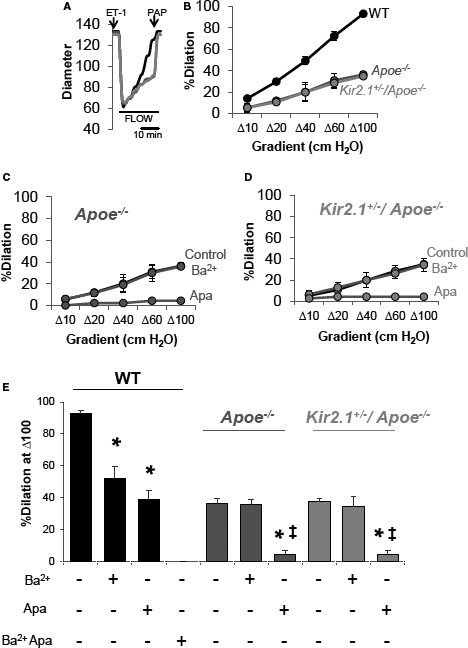Figure 3.

Hypercholesterolemia‐induced reduction of flow‐induced vasodilation (FIV) in inwardly rectifying K+ (Kir)–deficient mouse mesenteric arteries. A, Representative traces showing dilations to increasing intraluminal flow in arteries isolated from wild‐type (WT), apolipoprotein E–deficient (Apoe −/−), and Kir2.1 +/− /Apoe −/− mice. Arterial diameter was continuously monitored and a measurement was recorded every 30 seconds. Endothelin 1 (ET‐1) (1.2–2×10−10 mol/L) was used to preconstrict the vessels before an FIV protocol. At the end of an FIV protocol, papaverine (10−4 mol/L) was used to determine endothelium‐independent function and validity of the previous FIV protocol. In most cases, papaverine induced dilations >95%. B, Group data showing the full dose response to flow using the pressure gradient method in each model. For WT, 6 arteries from 4 mice; Apoe −/−, 4 arteries from 4 mice; and Kir2.1 +/− /Apoe −/−, 4 arteries from 4 mice. SEM was calculated using the number of mice. Inhibitors of Kir (Ba2+; 3×10−5 mol/L) and small conductance Ca2+‐activated K+ (apamin; 2×10−8 mol/L) channels reveal the contribution of Kir channels in (C) Apoe −/− and (D) Kir2.1 +/− /Apoe −/− mice is abolished while the function of small conductance Ca2+‐activated K+ remains intact in response to intraluminal flow. E, Group data highlighting differences in response to Δ100 cm H2O determined by Bonferroni correction after 2‐way repeated measures ANOVA. *P<0.05 vs control (no inhibitor) and ‡ P<0.05 vs Ba2+.
